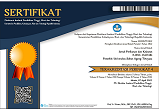The Effect Of Ketapang Leaves Extracts (Terminalia Catappa) In Inhibiting The Growth Of Bacteria Edwarsiella Tarda On In Vitro Test
Abstract
Keywords
Full Text:
PDFReferences
Brooks, G. F. Butel. J.S Morse. 2005. Mikrobiologi Kedokteran. Alih Bahasa. Salemba Medika. Jakarta. 317-27 hlm.
Cowan, M.M., 1999, Plant Products As Antimicrobial Agent, Clinical Microbiology Rewiews, 564-582.
Dawn, M., Allan, M. and Collen, S. 2000. Biokimia Kedokteran Dasar. Terjemahan dari Basic Medicsl Biochemistry, oleh Bahran, P. EGC, Jakarta
Diniarti, Eka. 2013. Isolasi Dan Karakterisasi Bakteri Edwardsiella tarda Penyebab Penyakit Pada Ikan Air Tawar. (http://etd.repository.ugm.ac.id/index.html, diakses pada 27 Agustus 2015).
Djojoseputro, Soedarsono., 2012. Resep & Khasiat Jamu tradisional Nusantara. Surabaya : Penerbit Liris.
Ghufran, M. dan Kordi, K. 2004. Penanggulangan Hama dan Penyakit Ikan. Rineka Cipta, Jakarta
Harborne, J., 1996. Metode Fitokimia: Penuntun Cara Modern Menganalisis Tumbuhan. Cetakan kedua. Penerjemah: Padmawinata, K. dan I. Soediro. Bandung: Penerbit ITB.
Hardiko, R. S., 2004, Aktivitas Antimikroba Ekstrak Etanol, Ekstrak Air Daun yang Dipetik dan Daun Gugur Pohon Ketapang (Terminalia catappa L.), Acta Pharm.Indon., 22(4), 129-133.
Lukistyowati, I. Studi Efektifitas sambiloto (Andrographis Paniculata Nees) Untuk Mencegah Penyakit Edwardsiellosis Pada Ikan Patin (Pangasius hypothalamus). Jurnal Vol.40. No.2
Mulyani, Y., Bachtiar, E dan Kurnia, M. U. 2013 Peranan Senyawa Metabolit Sekunder Tumbuhan Mangrove Terhada Infeksi Bakteri Aeromonas hydrophila pada Ikan Mas (Cyprinus carpio L.). Jurnal Akuatika. 4(1):1-9.
Peta Sebar Hama dan Penyakit Ikan Stasiun Karantina di Provinsi Kalimantan Tengah, Palangka Raya. Stasiun Karantina Ikan Kelas I Palangka Raya
Pelczar, M. J. & Chan, E. S., 2008, Dasar-Dasar Mikrobiologi, Jakarta, Universitas Indonesia Press
Samsundari, S. (2006). Penggunaan bahan obat alami terhadapresistensi bakteri Aeromonas hydrophilla yang menyerangIkan Mas (Cyprinus carpio.Jurnal Gamma,2(1),71-83.
Sarida, M., Tarsim.dan Faizal, I. 2010. Pengaruh Ekstrak Buah Mengkudu (Morinda citrofolia L.) dalam Menghambat Pertumbuhan Bakteri Vibrio harveyi Secara In Vitro. Penelitian Sains. 13 (3); 59-61
Sine, Y. 2013. Uji Aktivitas Antibakter Ekstrak Daun Tanaman Ketapang (Terminalia catappa L.) dan Daun Tanaman Jambu Biji (Psidium guajava L.) terhadap Pertumbuhan Bakteri Aeromonas hydrophila. Skripsi. Universitas Nusa Cendana, Kupang.
Suryawiria, U. 2005. Mikrobiologi Dasar. Papas Sinar Sinanti. Jakarta
Turrohmah, S. 2018. Uji MIC (Minimum Inhibitory Concentration) Ekstrak Metanol Jamur Tiram Merah Muda (Pleurotus flabellatus) Terhadap Pertumbuhan Bakteri Pseudomonas aerugenosa. Diploma thesis, Universitas Muhammadiyah Semarang.
Volk, W.A and M.F. Wheleer. 1993. Mikrobiologi Dasar. Edisi Kelima. Jilid 1. Penerbit Erlangga. Jakarta.
Wahjuningrum, D., Ikhsan N.M., Sukenda., & Evan, Y. 2014. Pengaruh ekstrak kunyit sebagai pengendali infeksi bakteri Edwardsiella tarda pada ikan Lele. Jawa Barat. Jurnal Akuakultur Indonesia 13 (1), 1-10
DOI: http://dx.doi.org/10.33512/jpk.v10i2.9218
Refbacks
- There are currently no refbacks.



_-_Copy1.png)